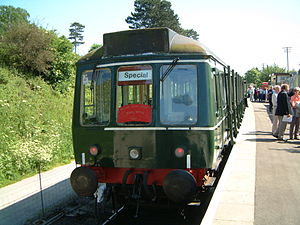British Rail Class 117
| British Rail Class 117 | |
|---|---|
 51402 at Northampton & Lamport Railway. This vehicle, along with 51367 has since moved to the Strathspey Railway. |

The British Rail Class 117 diesel multiple units were built by Pressed Steel from 1960-1961.
Operations
When first introduced, the units were all based with the similar Class 121 single carriage units on British Railway's Western Region for suburban work out of London Paddington, as well as South Wales (specifically Cardiff) and Cornwall. The units were largely based at Southall, Cardiff Canton and Plymouth Laira depots. The units remained here for many years working these services. In the 1980s, expiry of other DMUs facillated moves for some units from the Western Region to Birmingham, as below, and Scotland, prior to the delivery of new units to replace them. They were given refurbishments.
The first shake up in ownership occurred in the late 1980s, when the Scottish, Welsh, Cornish and Birmingham based units were transferred to Provincial Services, later Regional Railways, in the sectorisation of British Rail, while the Southall based units transferred to Network SouthEast.
They were replaced on the lines out of Paddington when the Class 165 'Network Turbo' units came into service in the early 1990s. Southall depot closed at this time when Reading DMUD opened to service the new units.
They soldiered on on the former Western Region until replaced by Class 150 and Class 153 DMUs. An attempt was made to remove them from Cornish work using Class 142 "Skipper/Pacer" units, but these non bogie units proved to be useless on the tight Cornish branchline curves, increasing rail and wheel wear, moving to the North of England instead. They were finally replaced with the advent of more Class 150s and Class 153s freed up from other areas. They continued to work in Scotland until the turn of the millennium, where they were replaced with class 150s and Class 170 Turbostar DMUs.
For many years, passenger services on the Birmingham Cross-City Line were worked by elderly Class 117, along with Class 115, 116, 118 and 121 diesel multiple units, but all were withdrawn from service by 1995.
In 2000 Class 150 Sprinter units replaced the Class 117 units on Silverlink, finally bringing to an end decades of service on Britain's rail network in front line service. This withdrawal caused quite a stir.
Preservation
Due to the type's longevity, several units have been preserved on heritage railways.
| Set number | Vehicle numbers | Livery | Location | Notes | ||
|---|---|---|---|---|---|---|
| DMBS | TCL | DMS | ||||
| 117204 | 51365 | - | 51407 | BR Green | Plym Valley Railway | - |
| 117301 | 51353 | - | 51395 | Regional Railways | Swanage Railway | Currently in store at private location |
| 117310 | 51381 | - | - | Regional Railways | Mangapps Railway Museum | - |
| 117311 | 51352 | 59505 | 51376 | BR Green | West Somerset Railway | - |
| 117313 | 51339 | - | 51382 | BR Green | Vale of Glamorgan Railway | - |
| L701 | - | - | 51392 | Network SouthEast | Swanage Railway | Currently in store at private location |
| L702 | 51356 | - | 51398 | Network SouthEast | Swanage Railway | Currently in store at private location |
| 117704 | 51341 | - | - | Network SouthEast | Swanage Railway | Currently in store at private location |
| 117709 | 51359 | - | - | Network SouthEast | Northampton & Lamport Railway | Awaiting restoration |
| - | 51342 | - | 51384 | EOR Blue | Epping Ongar Railway | - |
| - | 51346 | 59516 | 51388 | BR Green | Swanage Railway | - |
| - | 51360 | 59496 | 54289 | BR Blue/Grey | Ecclesbourne Valley Railway | 54289 is a Class 121 vehicle |
| - | 51347 | 59508 | 51401 | BR Blue/Grey | Nene Valley Railway | - |
| - | 51367 | - | 51402 | BR Green | Strathspey Railway | - |
| - | 51370 | - | 51412 | BR Green | Chasewater Railway | - |
| - | 51372 | - | - | BR Blue | Chasewater Railway | - |
| - | - | - | 51400 | BR Green | Mid-Hants Railway | Main-line certificated by RESCO |
References
- The Railcar Association
- Motive Power Recognition: 3 DMUs. Colin J. Marsden
- British Railway Pictorial: First Generation DMUs. Kevin Robertson
- British Rail Fleet Survey 8: Diesel Multiple Units- The First Generation. Brian Haresnape
- A Pictorial Record of British Railways Diesel Multiple Units. Brian Golding
